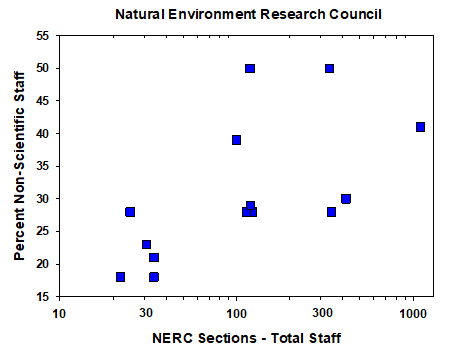To save myself from the current problems of funding science in general in North America, I would like to ask an impossible but perhaps interesting question: What research would ecologists carry out if they had ten billion dollars of funding? This of course is a ridiculous question, but it is interesting because it would focus our minds on what the major issues of our time are in the ecological sciences and where to go next. The history of the hard sciences like physics, chemistry and medicine is punctuated with a specification of the most important issues that need solving. These specifications change as progress occurs in each science so that there are many books about successes in solving problems in these hard sciences. Could we do this in ecology and what might this list of problems and possible solutions look like?
The first response is that ecology is not a hard science like physics and chemistry with a plethora of well-defined laws. I think this is a cop-out. Ptolemy and Newton and Darwin did not avoid these questions and forged new ways of thinking in their respective sciences. A second response is that ecological science deals with contingent events much as geological science does. We can understand volcano eruptions and tsunamis, but we cannot predict if, when and where they will occur in the same way we can predict that a bridge will fall over if the construction materials are not correct.
We have in ecology today two major schools of thought about what are the most critical issues that ecologists need to investigate. The first school of thought is that we need to understand how populations and communities are structured, how their components interact, and how much these ecosystems vary in different parts of the Earth. We have adequate to good methods to investigate these questions but lack the funding at present. The major unanswered questions within this paradigm are how these ecosystems will respond to global change with respect to human population growth and climate change. But these questions can only be answered with long-term studies, both observational and experimental. The system is hampered by two constraints – the length of an individual scientist’s research, and the short-term view of funding which assumes all these questions can be answered with 3-5-years of research funding. We can achieve success only by establishing teams of ecologists that focus on major questions and cooperate with observations and experiments that exceed the ability of a single scientist with a limited research lifespan. Success on this front can be seen most readily in the aquatic sciences, avian and mammal ecology and least readily in the ecology of the small guys – insects, bacteria, viruses. So, our current understanding in population and community ecology is best with the species we can eat and with large species rather than small. There is no question but that these advances in ecological knowledge are more difficult in the tropical countries with more complex ecosystems and in general less money for research.
The second major school of thought in the ecological sciences is biodiversity science. This school of thought passes over all the problems of ecosystem ecology to describe the species that exist on Earth. This is a gigantic problem because of the large number of undescribed species. We make progress on this list slowly, and at present if you pick up a plant, small animal, and insect, or a bacterium among other species it is impossible to assign a taxonomic name and description. Progress in identification is progress is moving rapidly because of DNA technology but the desirable target of having an inventory of life on Earth is still a long way off.
Given that we have this partial inventory, the major issue of biodiversity science is the problem of extinction – we do not want to see any species go extinct. This is a tall order but an important one. And it is here that the two major schools of ecology must join forces because you cannot understand extinction unless you have adequate knowledge of the role of each species in the ecosystem. If you read the news today, you will become rather depressed because of reported rates of extinction at the present time. The sentiment is good; the data are poor. An unresolved problem is that most species are rare. We humans notice the big species and the colourful birds and insects, but rare species are difficult to study. News media report every species that was thought to be extinct because none were seen for perhaps 20 or 30 years but now a few were found again. With enough funding and person-power ecologists could analyse the details of extinction in a few species but there is no hope that this could be done for the small fauna that are rare and expensive to find.
So, the take home message is that the two major schools of ecology must interact more to achieve success on both fronts but the shortage of funding and the shortage of ecologists in each of the two major areas are limiting. At some point this will change. There are many very wealthy people in western countries who could fund a very large sum of money for ecological science. To date such a financial event is rare, and a possible reason for this is that the ecological sciences do not support economic growth and human health in the same way that physics, chemistry and medicine do. The ecological costs of economic growth are largely ignored, and the two largest of our global problems are climate change and human population growth which exceeds the carrying-capacity of the Earth. Both issues operate on a time scale greater than the average human lifespan, so we pass the problem on to our children. Ecological science is caught in the trap of not increasing the god of GDP and reporting more problems every day than it is solving. We have a long way to go, and it is important that ecologists look at the long-term and adjust their scientific goals accordingly. Much talk is good if it leads to much action. But action cannot be done without funding.
Duda, M.D., Beppler, T., Austen, D.J., and Organ, J.F. 2022. The precarious position of wildlife conservation funding in the United States. Human Dimensions of Wildlife 27(2): 164–172. doi:10.1080/10871209.2021.1904307.
Gallo-Cajiao, E., Archibald, C., Friedman, R., et al. 2018. Crowdfunding biodiversity conservation. Conservation Biology 32(6): 1426–1435. doi:10.1111/cobi.13144.
Guénard, B., Hughes, A.C., and Williams, G.A. 2025. Limited and biased global conservation funding means most threatened species remain unsupported. Proceedings of the National Academy of Sciences 122(9): 2412479122. doi:10.1073/pnas.2412479122.
Lant, M., Bendel, C.R., Parent, C.J., and Kaemingk, M.A. 2025. A need for assessing the resiliency of conservation funding. Ecology and Society 30(3): 9. doi:10.5751/es-16322-300309.
Papp, C.R., Scheele, B., Rákosy, L., and Hartel, T. 2022. Transdisciplinary deficit in large carnivore conservation funding in Europe. Nature Conservation 49: 31–52. doi:10.3897/natureconservation.49.81469.


